|
 |
 |
 |
| |
JANUARY 11 - FEBRUARY 2 , 2002
GRAIN
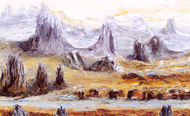
GRAIN Robert Pledger |
 |
An unusual collaborative installation takes over the gallery in the form of painting and monumental paper sculpture. Robert Pledger's richly encrusted canvasses are primeval landscapes populated with craggy mountains, sulphurous skies and dark, cave-like pockets. At times the scenery seems to be animated with odd creatures, faces and peculiar formations which beguile and immerse the unwitting traveller. |
Pat Gibson and Marion Bray develop these mindscapes into three-dimensional space by massing, twisting, stitching and weaving paper into pulpy fields and airborne structures through which the visitor navigates. Finding inspiration in organic forms, both microscopic and macrocosmic, the work explores the passage from the mundane to the mystical, leaving traces of history in its wake.
Andrew Parker's black and white photographs of World War II pillboxes are stark yet evocative depictions of simple concrete structures, which exists in various stages of decay. Now divorced from their function as shelters, they appear incongruously as 20th century ruins within idyllic countryside and along beautiful stretches of coastline.
Acrylic paintings by David Harkins are concerned with symmetry, balance and memory: how we achieve and sustain equilibrium, and manage to live without falling over.
|
|
|
| |
|
 |
| |
FEBRUARY 8 - MARCH 2 , 2002
TRANSENCOUNTER
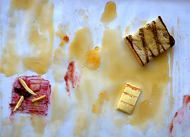
TRANSENCOUNTER Imke |
 |
Ingrid Kerma and Pierre Imhof are two painters who intermittently merge identities to become the artist commonly known as Imker. Working simultaneously on the same canvas, the artists shed their egos in submission to this new entity, whose palette ranges from rainbows of paint to fried eggs and jam. Kerma's paintings are contemplative fields of rich and subtle pigment, in contrast to Imhof's exuberant and gestural pieces. In this show you will witness both the independent and collaborative efforts of this trio. You might try to work out who did what in each piece, until you realize it doesn't really matter, and surrender yourself to the delicious pleasures of paint. This exhibition launches Imker's new catalogue, with contributions from Matthew Collings and Adrian Rifkind. |
Liv Stokkan's sculptures are uncanny hybrids of artificial light, soft materials and found objects. Interacting with gravity and daylight, these ephemeral assemblages trigger associations with the human body-skeletal and reproductive structures, skin, and protective coverings. You may encounter one in a corner, softly glowing and coddled in lace, or dangling overhead like a discarded shell.
|
|
|
| |
|
 |
| |
MARCH 8 - 30, 2002
YOU ARE HERE
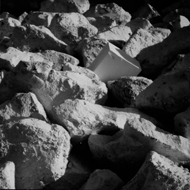
YOU
ARE HERE Jonathan Froud |
 |
Travelling along the South Downs from Chichester to Brighton, Artel is an affiliation of artists who come from many different disciplines. The group assigned itself a task: for each artist to choose one square from the Ordnance Survey map of the region, and to create a piece in response to this location. Inspired by the material of their surroundings, some artists incorporate chalk, salt and gravel into their work, whilst others explore through paint, computer or video imagery the interaction between the man-made and natural environment. Pervading this project is an interest in landscape's function as an historical record, which like a map or a work or art, can be read by the attentive viewer.
|
Shane Waltener and Steve Morgan transform Phoenix into an alternative tourist attraction. Visitors are invited to participate in a guided tour/scientific experiment, which highlights the special features of the vicinity. These points of interest are indicated by thought bubbles and mathematical diagrams applied to the windows and framing the outside view, and further expounded in the accompanying guidebook. A sound track consisting of ambient sound, musical fragments, and narration will create aural fictions drawing on the living history and psycho-geography of the locality, and interact with the visitor's imagination to create a unique mental map of the place.
Paintings by Andrew Gathercole arise from research, contemplation, and journeys made.
|
|
|
| |
|
 |
| |
APRIL 5 - 27, 2002
THE HAVEN
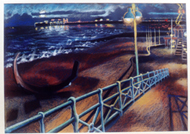
The Haven - Oscar Romp |
 |
Oscar Romp was recently artist-in-residence at The Beacon, a residential and day centre in Brighton for people with HIV. During this period, he produced a large, site-specific painting for The Beacon, as well as a number of paintings and drawings, and worked with clients to facilitate their own creative expression in coming to terms with their personal circumstances. In this show we see Romp's lyrical "culturescapes" of Brighton. Perched at the top of a hill, The Beacon affords a bird's eye view of the area. At various times of the day, Romp's eye navigates the twists and folds of the downs as they descend into the jewel-like city below. Night time views along the seafront, scenes of revelers at local clubs and introspective portraits appear within this body of work, coupled with soul-searching pieces by clients who worked alongside the artist. |
An installation by Caitlin Heffernan draws upon perceptions of the body and its relation to interior and exterior spaces. Using delicate and pourous materials to create skin-like membranes, the artist creates clusters of cellular shapes, which can be approached, viewed and walked through, creating an experience which is both sensual and menacing.
Jill Bouchier's canvasses incorporate horizontal and vertical bands of paint which create subtle optical effects in relation to light, space, and the viewer's position. The serene surfaces have a cool, yet hand drawn quality, and invite the eye to explore the subtle shifts of tone and rhythm.
|
|
|
| |
|
 |
| |
MAY 3 - 25, 2002
TEMPORARY ACCOMMODATION
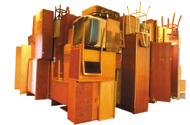
Temporary Accommodation
Sonja Wyndham-West |
 |
An architectural installation by Sonja Wyndham-West explores the perceptual and emotional states that living in an impermanent situation can bring. Incorporating abandoned domestic furniture, building materials, and found objects, the artist creates a fortress of memories and associations arising from the urban environment. The private, sometimes claustrophobic space of the bedsit or hotel room is juxtaposed with the abstract and impersonal landscape of the city, as experienced in the back alley, cul-de-sac, and hidden street corner at night. Mirroring the experiences of the marginalized and nomadic urban dweller, this piece serves as a metaphor for the 'human condition' allowing the visitor a glimpse of their own interior spaces.
|
Workshop: Storytelling and Image-Making. A storyteller and artist guide you through the rooms of your imagination, drawing upon the exhibition for inspiration. This hands-on workshop involves stories, games, collage and drawing, and is suitable for adults 16+ from all backgrounds. Tutors: Pat Bowen and Marion Charles.
Sunday, May 19, 10:30 am - 3:30 pm. £20 / £15 conc. Early registration (May 3): £14. Please pre-register using workshops form.
Workshop for Children: Imaginary Spaces. Create and play in your own temporary space, using construction, painting, story making, dressing up and fantasy. Parents / carers are welcome to accompany their children.
Led by Mary Dawson & Sonja Wyndham-West
Sunday, May 12, £6 / £5 conc. Early registration ( April 26) £4. Accompanying adults free. Please pre-register using workshops form.
I: For children ages 5 - 9. 10 am - 12:30 pm.
II: For children ages 7 - 11. 1:30 - 4 pm.
|
|
|
| |
|
 |
| |
MAY 31 - JUNE 22, 2002
RUMBLE IN THE JUMBLE
This month the gallery is graced by a convulsive, compulsive celebration of stuff. Feast your greedy eyes on stickers, badges, records, cats, toys, junk, and other pop-culture ephemera lovingly gathered from the charity shop, supermarket, and skip. Highlights of the show include the art of local music fanatic DJ Ordeal, whose easy listening album covers are graced by sultry women peering from beneath mists of spray painted gloss. Meanwhile, Lee Campbell creates bright and shiny landscapes from masses of stickers and bulk advertising. Joining them with other intriguing displays will be some of the region's most notorious collectors, and the exhibition will be punctuated with spontaneous outbursts of sound. |
 |
|
|
|
|
| |
|
 |
| |
JUNE 28 - JULY 20, 2002
UNDERLINES
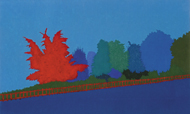
Underlines - Eilidh Crumlish |
 |
Two painters take memory and landscape as starting points for divergent journeys. Wars, stories of loss, and notions of the picturesque are themes underpinning Anna Oliver's map-based canvases. The artist examines the way in which personal and political events can be located, explained, systemised and controlled through close and meticulous examination. Eilidh Crumlisch is concerned with the evocative power of places and objects. Drawn from the urban and rural landscape, these intimate canvases explore the use of strong colour and sharp line to create work that conveys a quiet sense of place.
|
Sharon Haward's paintings strike a balance between the physical and illusionistic properties of her materials. Referring to sources as disparate as architecture, biology and current events, the pieces use transparent and opaque layers of pigment to create subtle passages of texture and light.
|
|
|
| |
|
 |
| |
JULY 26 - AUGUST 17, 2002
EVERYDAY THINGS THAT DON'T EXIST
David Clooney's large-scale collage installation begins with simple photographs of objects and places, and these are transformed, via photocopier and computer, into images resembling stars in the night, microscopic organisms and Rorschach inkblot tests. Other works utilise a range of approaches, from the painterly to the mechanical. Each piece reveals the artist's subtle hand in guiding the process of repetition to re-present the familiar in a new and startling form.
Matthew Richardson's digital and traditional prints, collage and mixed media works operate in the space between perception and knowledge. In one series of images, uncanny shapes scorch the pages of an old book, and in another, the artist toys with apparently random marks that begin to suggest objects and obscure symbols. He is interested in exploring how we decipher meaning and messages, and looks to the edges of fields, footprints and ghosts for clues.
Paintings by Helen Melland are influenced by graphic design, cartoon imagery, graffiti and organic and bio-medical forms. Colour, line and various types of pigment are utilised to develop a rich variety of surfaces and shapes, and these are the stimuli which transport us into alternative worlds.
|
 |
|
|
|
|
| |
|
 |
| |
SEPTEMBER 6 - 28 , 2002
REPLICAS
Guy Dale's photographic and site-specific works invite us to interpret our surroundings in new and unaccustomed ways. Projected images and shifting perspectives disrupt our perception of the gallery space, and we also encounter ordinary items which, on closer inspection, are not quite what they seem.
Photographs by Roger Hopgood present familiar objects in unfamiliar combinations. Whilst alluding to larger social issues, the uncanny juxtaposition of images does not offer a straightforward interpretation, but rather serves to create a tension between rational and intuitive responses.
Microscopic organisms and lunar landscapes, rows of seedlings and furrowed fields are some of the images suggested in the subtle and illusory paintings by Lesley Jones. Arising from the artist's close observation of the natural world, the mirror-smooth canvases play with our perceptions of scale and form, whilst creating a tranquil space through which the imagination can wander.
Alan Pierce's mixed-media paintings are concerned with the interaction between the physical environment and forces of decay. Passages of weathered, flaking paint, wire and incised line simultaneously resemble architectural fragments, and re-enact the natural processes of dissolution.
|
 |
|
|
|
|
| |
|
 |
| |
OCTOBER 4 - 26 , 2002
HANG TEN
This year marks Phoenix Arts Association's 10th anniversary, and we are riding the wave of our success by hosting a special exhibition and related events. Hang Ten celebrates the artists who have been part of Phoenix over the past decade, and sheds light upon our unique history. Lively, diverse and informative, the show features specially produced work in various media, alongside information about the artists and the development of the organisation from the early days up to the present. Visitors will also be invited to add their own contributions to a collaborative installation.
PHOENIX OPEN WEEKEND
Friday October 18, 7 - 9 pm, Sat & Sun October 19 - 20, 1 - 6 pm.
Be at the centre of events this weekend, when we open our doors for a major celebration. Set up by artists in 1992, Phoenix has developed into one of the country's largest visual arts groups, and houses nearly 100 studios, along with a contemporary art gallery and a wide range of workshops and related activities.
You are invited to visit the artists in their studios, attend free workshops for children and adults, enjoy exhibitions, a café, music, performances and more.
|
 |
|
|
|
|
| |
|
 |
| |
NOVEMBER 1 - 23 , 2002
TRUE NATURE
Crafted from clay, formica, gold, peat, jelly and handcream, John Holland's little sculptures of flora and fauna, the natural and the manmade, are at once beautiful and mildly vulgar. These quirky creations congregate on special plinths, forming tableaux which tread a fine line between the Romantic tradition and DIY.
James Ingall's big paintings focus on the minute and mundane, orchestrating reality through the use of close-up views and a camera-like focus. By mimicking and distorting their photographic and digital sources, the works suggest parallels between the processes of painting and digital manipulation.
Peter Monkman has produced an obsessive diary of tiny drawings which record the passage of time, ranging from time spent watching a single movie on TV to the every day events and scenarios experienced over an entire year. These personal storyboards are produced as if the artist is directing his own imagined movie, with the spectator being invited to decipher the narratives within.
Dominic Pote's photographs explore the possibilities of representing the dynamics of time and movement within a panoramic format. Strongly contrasting elements often appear together in the landscapes. Brutal, architectural forms collide with the natural environment, but the result is a softening of the distinctions, and an almost painterly image quality.
Traces of still-lives, travels abroad, and domestic settings can be detected in a series of exuberant and colourful canvases by Madeleine Walton. The artist calls upon memory, abstraction and intuition to develop a rich latticework of marks and gestures, and leaves us to enjoy the resulting sensations.
|
 |
|
|
|
|
| |